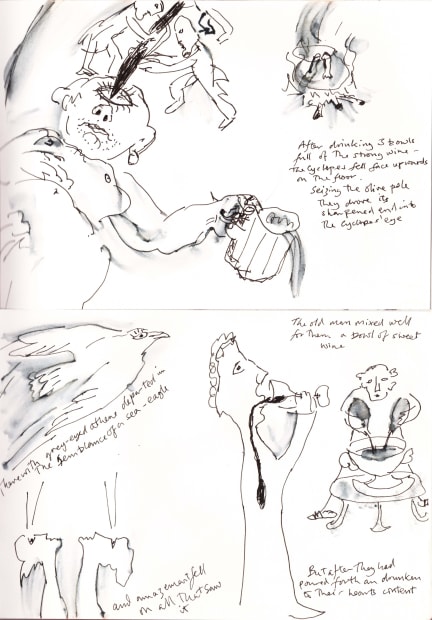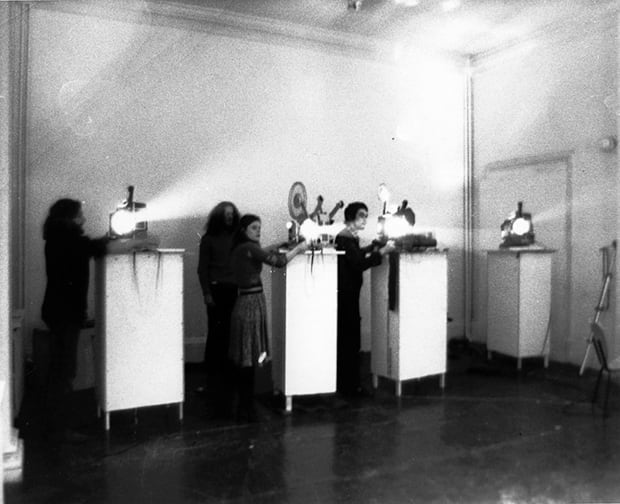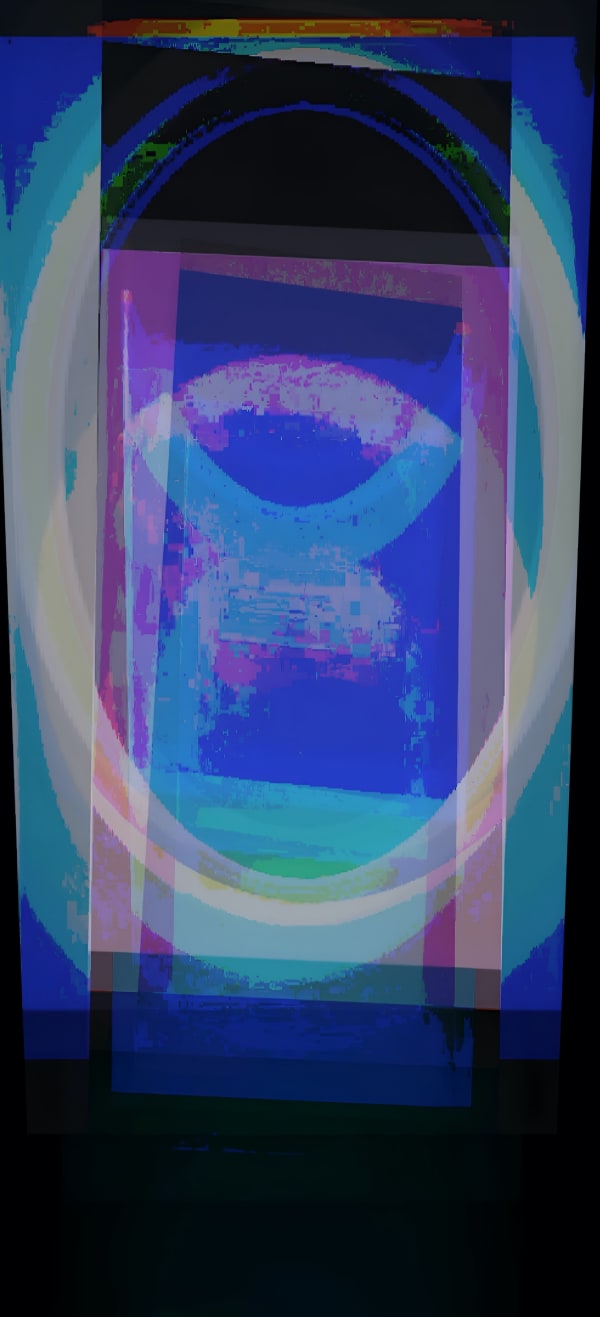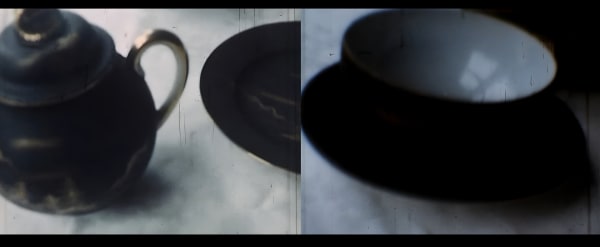-
DNA : AND - MALCOLM LE GRICE SELECTED WORKS 1960 - 2024
-
The British Film Institute (BFI) describes Malcolm Le Grice (b.1940) as “probably the most influential modernist filmmaker in British cinema". Since the mid-1960s, a period in which he showed his first, groundbreaking short films at the London Arts Lab, an influential hub for the capital’s counter-culture, and founded the workshop at the London Filmmakers Co-operative, Le Grice has been exploring the intersection of art, science and technology. His entire catalogue of 80-plus films is now held in the British Film Archive as well as being represented in the permanent collections of the Tate, the Archives of the American Academy, the Royal Belgian Archive, the Museum Of Modern Art in New York, the Pompidou Museum in Paris and MoMA in Barcelona.
Born in Plymouth and a resident of Thurlestone between 1999 and 2022, Malcolm Le Grice returns to Devon this Autumn at Velarde for a very special exhibition. DNA : AND — Malcolm Le Grice, Selected Works 1960-2024 presents video installations, selected 2D work, including original and recently rediscovered early paintings and drawings, and limited edition prints from some of his most celebrated films. Le Grice’s work interrogates the complex relationships between the processes of filmmaking and the politics of perception. Exploding the structures of conventional, linear, narrative-driven cinema, his films set out to question what it is that happens when the spectator engages with something, or as he puts it “the moment of encounter”. His abiding interest in the mathematics of perspective, the contradictions of multi-viewpoint and the representation of time extend a thread through art history that links Cubism, Futurism and Serial Photography with the works of contemporary artists such as Martin Creed, Steve McQueen, Matthew Barney and Douglas Gordon.
The work in this exhibition traces through more than six decades of activity and represents the many genres and media in which Le Grice has worked, and yet remarkably it is still a small proportion of his output. The themes into which the show is split are deliberate but also somewhat artificial. Likewise, it is not the intention to create a ‘retrospective’ or to place the work in a specific timeline. The real fascination and surprise is to recognise the congruity in the thought process and creative activity that weaves itself through and behind the work. This is something that the artist himself has found interesting, being able for the first time to interrogate the output as a whole, including many paintings and early works which have recently been unearthed due to a comprehensive archiving process supported by DACS.
It is pertinent that perhaps the most important thread running through the work is the fascination with DNA, and systematic, algorithmic aspect in the process of artistic creation. That process being ongoing and potentially with no ultimate end point. Further to this, but connected, is the assertion that the artwork only really exists once it has passed the eyes and into the conscious (or unconscious) mind of the audience, as an active participant in that creative process.
Curated by Oliver Le Grice and Nikki Elphinstone.
-
-
60's Paintings
The paintings are either early large-scale canvases or paper works in acrylic or watercolour. The influences for these work as were self -programmed and generative projects, particularly those exploring forms drawn from the mathematics of Topology, a branch of geometry that studies shapes that can be stretched and moved while points on the shape continue to stay close to each other. Many of these paintings trace sequential pathways through colour sectors, some of which become sources in colour field films like ‘Threshold’ (1972).
-
Charcoals and Etchings
All the etchings were made between 1961 and 1963, and most of the charcoal drawings were made between 1961 and 2000. The earliest charcoal drawings relate to the film Little Dog for Roger, a film made from recovered fragments of the primitive home-movie medium 9.5 millimetres celluloid. It was shot by Le Grice in 1947. His son Oliver reworked the fragments on a primitive home-made 16mm printer.
-
Faces and Punks
“These are mainly recent colour prints (dated 2020 - 2022) developed from some hundred or more drawings from the 1960s. The Faces follow the post-modern influence that celebrates individuality in the face, rather than a search for ideals of beauty, and is influenced by Matisse and Mondrian. It is also true that many of the Punks were strongly influenced by Picasso. These were produced whilst teaching at Central Saint Martins. I became very excited by the way the new experiments with the faces and makeup of young people walking the streets had now become the new look of reality.
“One group of these prints were produced by drawing with my finger on to a mobile phone whilst lying on my back during dialysis sessions.” Malcolm Le Grice, 2024
-
Dogs
An imaginary set of drawings under the title Pablo’s Dog reflecting on components of the Cold-War.
-
Jazz
This series of prints relates to Le Grice’s involvement in live performance. The earliest of these re-works a newspaper photograph of a large “Jazz” mural for the refectory of the Plymouth College of Art. The underlying principle of improvisation in jazz music is central to a series of performance works, particularly the theatrical 3D shadow performance Horror Film 2, and the 3 -projector work Horror Film 1. This film continues to be performed internationally by others since 2021 using a prepared score to guide the choreography.
-

-
Bathers
These prints are in the tradition of female nude representation, they have no voyeuristic motive nor fixed gender of the body. So, where art has often concentrated on the female representation of the nude, the bathers are all clothed. The Bathers series also connects to the Botticelli Venus in the glass box assemblage After Leonardo.
-
DNA
“DNA and its mechanisms have always underpinned my formal aspects of a post-perspective art philosophy and process, as well been scientific interest in and of itself. The uncovering of older work during the archival process supported by DACS has recovered intuitive drawings from the 1960’s and 70’s which reveal an unconscious underlying interpretation linking with the synaesthetics of colour and sound explored in the later computer and colour-field videos and stills.
Topology
“Some paintings I did in 1964 involved cutting a strip of canvas from the back and joining to the front so that I formed a form of Moebius strip. At the time a sculptor friend introduced me to the field of topology. In particular, he alerted me to a 3D version called the “Cross Top” that involved a complex range of interconnections. In order to understand the complexities of the inter-connections offered by the cross top I created a small model in plasticine with all 8 surface sections in a different colour. I then, with a pin, traced every possible loop on the surface and methodically recorded each of these. By reviewing all the recorded pathways, I could discover all possible loops, creating a catalogue of elements that enabled me to predict where there were connections I’d not previously identified.”
-
-
“To my surprise, through collaboration with artists Lucas Ihlein and Louise Curham in Australia I found that I had been included in a major university project to develop a unique form of solid synthetic DNA as an information storage system. As part of the project some of my film work was encoded onto the DNA to test this storage system. This has rekindled my interest in DNA, not only for storage, but as the possible basis for a creative generative programming system (an equivalent to Boolean algebra). Reproductive coding and random intervention that is yet to be explored." Malcolm Le Grice, 2024
The DNA storage capsule project in this exhibition is a collaboration between Dr Lucas Ihlein (University of Wollongong), Dr Louise Curham (Curtin University), Professor Raja Appuswamy (Eurecom), Oliver Le Grice, and Malcolm Le Grice. For more info follow this link: https://teachingandlearningcinema.org/expanded-cinema-re-enactments/mlghf1oatlc/
-
AFTER MANET
“Throughout my life I have explored some of the major formal issues in art through theory and practice. In particular following Cezanne and the Cubists in their questioning of perspective and multi viewpoint. As part of this I have also innovated in the development of film and video technology but I have rarely focused on exploring the most common art genres like landscape and still life. By exception there are two computer works that explore still life through the computer programme and several works that take a special view of narrative and landscape. Each of these involve a study of multi-viewpoint. The earliest of these is a one-hour film After Manet based on Manet’s Le Déjeuner sur l'herbe (1862). It is situated in a country location and like the Manet original it has four performers. Though the action is strictly choreographed, all four performers take responsibility for one of the four cameras. It is eventually projected on four screens simultaneously without interference of interior editing. Any aspect of narrative and relationship between the characters is merely constructed by the viewer. This work follows in a period of intentionally non -narrative film making.” Malcolm Le Grice, 2024
-

-
Local
The local images were all produced during the period when the artist was living in Thurlestone, South Devon (between 1999 and 2022).
The centrepiece, Thurlestone Rock, originally a small film shot in a storm but dissected into frames and mounted as a black and white assembly, was originally titled Before I came and after you've gone. Walking by and Orchard are photo montage assemblies drawing on a collection of personal photographic images made whilst walking in central France. The montage Walking by transforms the sequentially into a two-dimensional lag-like structure. Orchard uses a linear sequence montage, transforming the grid structure by establishing visual links based on the branches and trunks of the trees.
-
AFTER LEONARDO
Incorporated within the influence of improvisation is the on-going video and music performance After Leonardo. The artwork incorporates moving projection and live recording as part of the performance. The actual music performances have included Keith Rowe of AMM and at the NFT, Ben Le Grice.
After Leonardo is also manifested in a photo collage and installation. This takes up the themes of cultural and historical changes in assumptions about the shifting idea of female beauty, the values of originality and meanings of art as a commodity. Part of this is an assemblage entitled Before and After Leonardo. Hanging inside a perspex box are two images, one on each side. On one surface is a black and white close-up of the centre of the Mona Lisa and on the reverse is a colour print of Venus by Lucas Cranach.
As a young student Le Grice made a collection of images kept in a rough folder. He became fascinated by how the Mona Lisa had become the most accepted icon representing the female face. Over time these images, initially pulled from a fashion magazine, became crushed and damaged through crazing and careless folding, they began to carry all the traces of ageing. In doing so they came to represent the way the cultural meaning of the work changed through time.
-
AVAILABLE FOR PURCHASE
A collection of original film stills on acrylic glass-
 Malcolm Le Grice, Spectral 1 (Film Still), 2024
Malcolm Le Grice, Spectral 1 (Film Still), 2024 -
 Malcolm Le Grice, Spectral 2 (Film Still), 2024
Malcolm Le Grice, Spectral 2 (Film Still), 2024 -
 Malcolm Le Grice, Spectral 3 (Film Still), 2024
Malcolm Le Grice, Spectral 3 (Film Still), 2024 -
 Malcolm Le Grice, Dark Trees (Film Still), 2024
Malcolm Le Grice, Dark Trees (Film Still), 2024
-
 Malcolm Le Grice, Berlin Horse Assemblage 12, 2024
Malcolm Le Grice, Berlin Horse Assemblage 12, 2024 -
 Malcolm Le Grice, Castle 1 (Film Still), 2024
Malcolm Le Grice, Castle 1 (Film Still), 2024 -
 Malcolm Le Grice, China Tea (Film Still), 2024
Malcolm Le Grice, China Tea (Film Still), 2024 -
 Malcolm Le Grice, Digital Still Life 1 (Film Still), 2024
Malcolm Le Grice, Digital Still Life 1 (Film Still), 2024
-
 Malcolm Le Grice, Even The Cyclops Pays The Ferryman 9 (Film Still), 2024
Malcolm Le Grice, Even The Cyclops Pays The Ferryman 9 (Film Still), 2024 -
 Malcolm Le Grice, Finiti 1 (Film Still), 2024
Malcolm Le Grice, Finiti 1 (Film Still), 2024 -
 Malcolm Le Grice, Finiti 2 (Film Still), 2024
Malcolm Le Grice, Finiti 2 (Film Still), 2024 -
 Malcolm Le Grice, Finiti 3 (Film Still), 2024
Malcolm Le Grice, Finiti 3 (Film Still), 2024
-
-
AVAILABLE FOR PURCHASE
A selection of original drawings and paintings from the 1960's-
 Malcolm Le Grice, Untitled, 1965
Malcolm Le Grice, Untitled, 1965 -
 Malcolm Le Grice, Untitled, 1965
Malcolm Le Grice, Untitled, 1965 -
 Malcolm Le Grice, Untitled, 1965
Malcolm Le Grice, Untitled, 1965 -
 Malcolm Le Grice, Untitled, 1965
Malcolm Le Grice, Untitled, 1965
-
 Malcolm Le Grice, Untitled, 1965
Malcolm Le Grice, Untitled, 1965 -
 Malcolm Le Grice, Untitled, 1965
Malcolm Le Grice, Untitled, 1965 -
 Malcolm Le Grice, Untitled, 1965
Malcolm Le Grice, Untitled, 1965 -
 Malcolm Le Grice, Untitled, 1965
Malcolm Le Grice, Untitled, 1965
-
-
AVAILABLE FOR PURCHASE
LIMITED EDITION PRINTS ON HAHNEMÜHLE PAPER (EDITIONS OF 9) -
FOR A FULL LIST OF WORKS PLEASE CONTACT THE GALLERY









































































